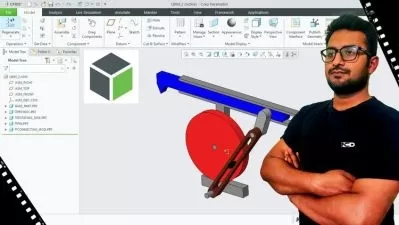Explore Pump Hydraulic Calculations, Operation, and Control
Boostrand Training
2:36:00
Description
Learn how the centrifugal and reciprocating pumps operate, how to calculate pump main parameters as a chemical engineer
What You'll Learn?
- How pump curves work and get the operating point against system curve
- Calculate pump available NPSH and make sure that we are avoiding pump cavitation using solved examples
- Estimate pump differential head based on process needs and discharge side resistance using solved examples
- Calculate pump power
- Difference between the operation of a centrifugal pump and positive displacement
- Pump control methods
- Operation of pumps in series and in parallel
Who is this for?
What You Need to Know?
More details
DescriptionPumps have been the heart of any plant as they are the main equipment used to guarantee the required process flow or pressure. Pumps are used extensively in oil and gas, chemical, and petrochemical industries to pump different fluid types at various pressures and temperatures.
Without a pump or if there is a problem in the pump operation, this can cause a huge process disturbance, and in some cases, this may lead to process shutdown.
Sizing the pumps and their suction and discharge systems is one of the major carried-out activities by process engineers during process design. This course will not just explain the theory of operation of a pump against the process.
We will see live examples where we shall calculate main pump requirements such as:
Net positive suction head (NPSH)
Differential head
Hydraulic power
This will be through Excel sheets that will be provided in the course to teach you how to calculate these parameters. You shall have access to pump calculation sheets throughout the course.
In this course, we shall also see:
How the pump curve works and how to plot it against the system curve.
How the pump and process system interact with each other and how the pump responds and interacts with process changes or disturbances.
The difference between the pump curve of a centrifugal pump VS a positive displacement pump. We shall also see how each of them interacts with the discharge system differently.
Different control methods to make sure we are on the required pump operating point.
Different pump configurations, how to operate the pumps in series and in parallel, and how this is reflected on pump curves.
So cannot wait to see you in the course, and I hope it shall give you added value!
Who this course is for:
- Students in any engineering school
- Engineers who want to know more about pumps
Pumps have been the heart of any plant as they are the main equipment used to guarantee the required process flow or pressure. Pumps are used extensively in oil and gas, chemical, and petrochemical industries to pump different fluid types at various pressures and temperatures.
Without a pump or if there is a problem in the pump operation, this can cause a huge process disturbance, and in some cases, this may lead to process shutdown.
Sizing the pumps and their suction and discharge systems is one of the major carried-out activities by process engineers during process design. This course will not just explain the theory of operation of a pump against the process.
We will see live examples where we shall calculate main pump requirements such as:
Net positive suction head (NPSH)
Differential head
Hydraulic power
This will be through Excel sheets that will be provided in the course to teach you how to calculate these parameters. You shall have access to pump calculation sheets throughout the course.
In this course, we shall also see:
How the pump curve works and how to plot it against the system curve.
How the pump and process system interact with each other and how the pump responds and interacts with process changes or disturbances.
The difference between the pump curve of a centrifugal pump VS a positive displacement pump. We shall also see how each of them interacts with the discharge system differently.
Different control methods to make sure we are on the required pump operating point.
Different pump configurations, how to operate the pumps in series and in parallel, and how this is reflected on pump curves.
So cannot wait to see you in the course, and I hope it shall give you added value!
Who this course is for:
- Students in any engineering school
- Engineers who want to know more about pumps
User Reviews
Rating
Boostrand Training
Instructor's Courses
Udemy
View courses Udemy- language english
- Training sessions 45
- duration 2:36:00
- English subtitles has
- Release Date 2023/12/24











